2006 VOLKSWAGEN GOLF PLUS phone
[x] Cancel search: phonePage 1 of 541

Contents
Owner's Manual 2
. . . . . . . . . . . . . . . . . . . . . . . . . . . . . . . .
California Emissions Warranties 377
. . . . . . . . . . . . . . . . . . . . . .
Mobile Phone Package 392
. . . . . . . . . . . . . . . . . . . . . . . . . . .
RCD 310 Radio 426
. . . . . . . . . . . . . . . . . . . . . . . . . . . . . . . .
Supplement 477
. . . . . . . . . . . . . . . . . . . . . . . . . . . . . . . . . . .
USA Warranty and Maintenance 487
. . . . . . . . . . . . . . . . . . . . .
Page 7 of 541

About this
At the end of thi s Ma nual, y o u w ill fin d a nal
phabetical index .
The list of Abb reviations at th e end of the Man ual exp lai ns th e te c h nica l abbreviatio ns and d esignat io n s.
Direc tions (left, rig ht, fron t, back ) are in re fer
e nce to the driv in g dir ect io n unl ess noted other
wise.
a re only fo r ori en tation and a re
m ere ly used to help ex plain the tex t descript ions
and in str u cti ons.
T ec hni cal m odifications to th e ve hicl e th at
we re introduced after th e e ditorial deadlin e ca n b e
found in a Supplement, w hich is e nclose d w it h th e
manual.
All options and models are described \vi thou t t he ir being specifically identified as op tio na l e quip
m ent or m ode l ve rs io ns. So me of th e described
equipme nt may no t b e ins talle d o n yo u r ve hicle or
m ay onl y be availabl e in certain m arkets. co nsult the sales documen ts rega rdin g your ve
hi cle 's equip ment and op tions and contact your
Abo ut this Manual
aut horized Volk swage n dealer or authorize d Volk
swa gen Se rvic e Fac
ility for m ore informatio n.
A
ll info rmatio n in this Manua l corresponds to in
for mation availab le as of th e editoria l deadline.
D ue to ongoi ng vehicle development , th ere m ay
b e differ ence s betw ee n your ve hicle an d th e information in thi s Manual. N o leg al obligations or commitments ca n be deri ved from th e in for matio n, illu stratio ns or descriptio ns in th is Man ual.
If you sell o r l end your ve hicle, p lease make sure
that th e comple te Manua l se t is in th e ve hicl e.
Standard components of the set:
Warrant y and Mainten an ce bookle t
Ow ner's Manual
components of the set
Sup plement
Hadio or N av igat io n system
Mobile phone pac kages
Volk sw age n In div id ua l Owner's Man ua l
Page 20 of 541
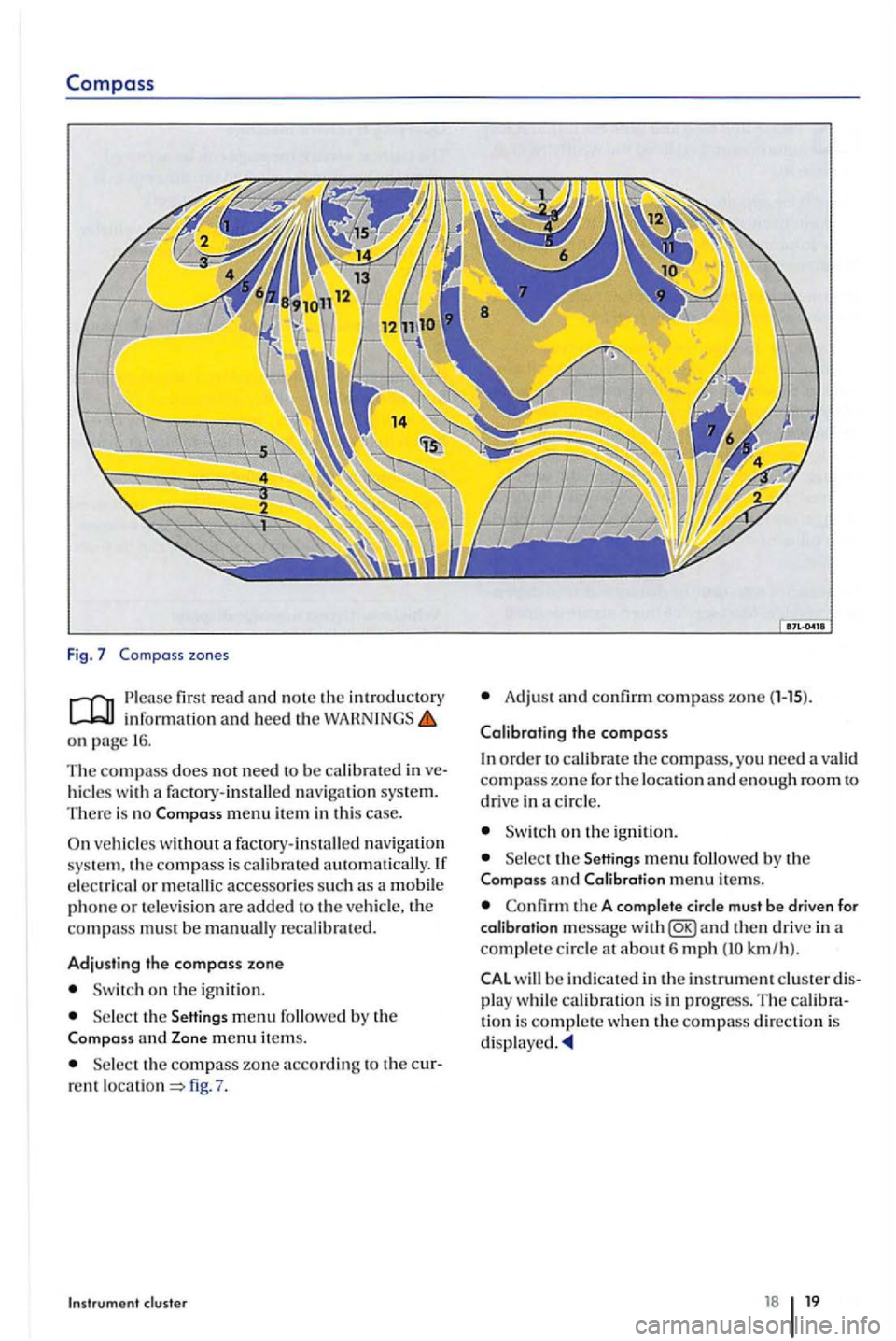
Compass
Fig . 7 Compass zones
Please read and no te the int rod uctory
on 16.
The compass does not need to be cnlibrated in hides with a factory-i nstnlled n av iga tion system. There is no Compass menu item in thi s case.
ve hicle s w ith out a fac tory-ins wlled naviga tion
sys te m . compass is acce ssories such as a mobile phone or telev is ion are added to the ve hicl e, the
compass m ust be manually re cal ibrate d.
Adju sting
the compass zone
on the ignit ion.
menu follo wed by the
Compa ss and m enu items.
rent
Adjus t a nd compass zone (1-15) .
Calibratin g
the compass
In order to calibrate the compass, you need a va lid
compass zone for the loca tion and enou gh roo m to
drive in a ci rcle.
on the ignit ion .
the A com ple te circle must be driven for
c alibration message w ith
play whil e calibrati on i s in progress. The tion is compl e te the compass direction is
Page 24 of 541
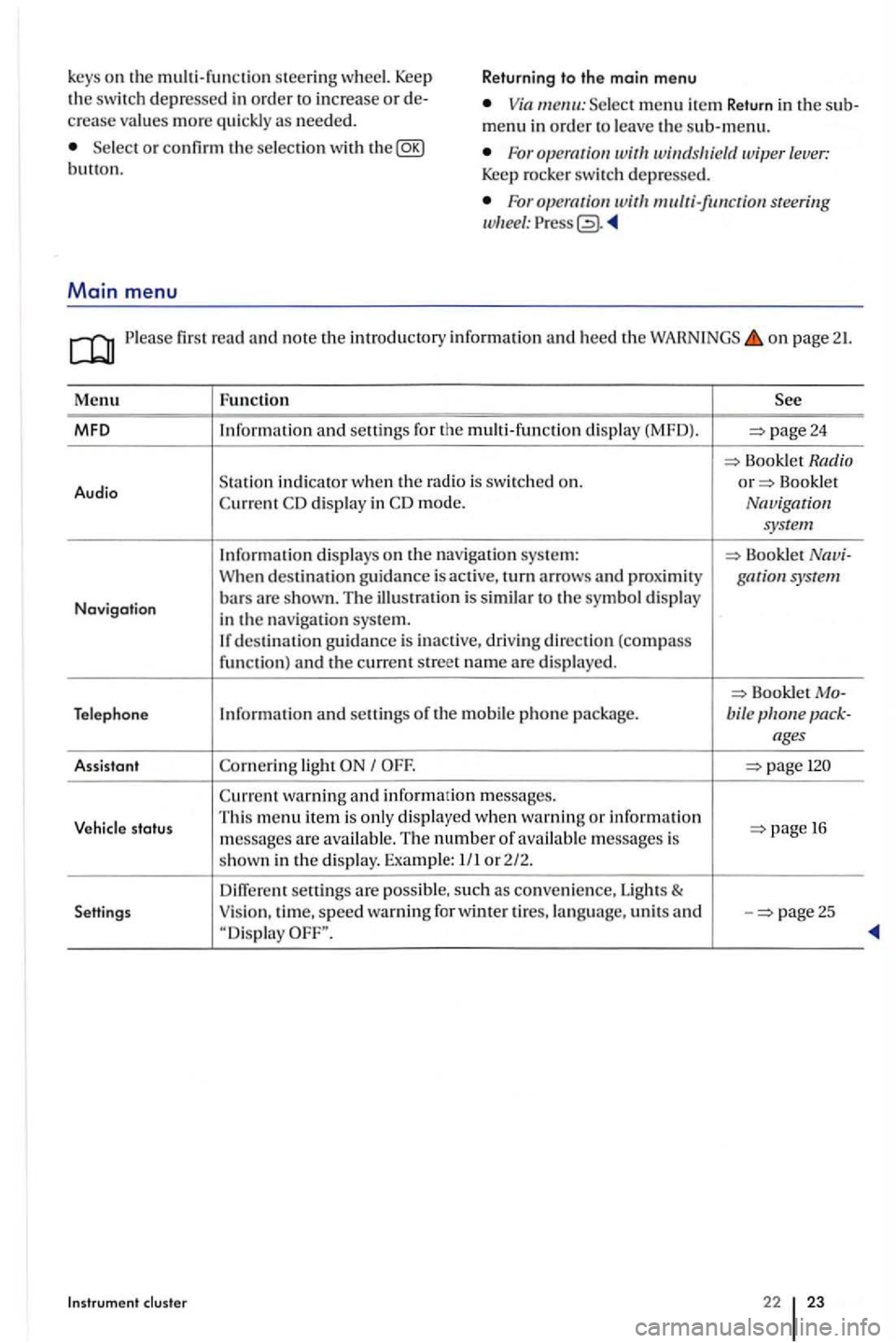
Return ing to th e main menu
key
s on the steerin g wheel. Keep the switch depressed in order to increase or crease values more qui ckly as needed. menu in order to leave the sub-menu. Se lect or confirm the selection w ith the Foropemtion Keep rocker switch depressed.
Main menu
For steering
first read and note the introd uctory inform ation and heed the on page 21.
Menu Fun ction
MFO and seuings for the multi-functio n dis play (MFD). page24
Book let Radio
Audio S
tatio n indicator when th e Bookle t display in mode. Navigation
system
Information displays on the nav igatio n sys te m : Booklet When destination guidance is acti ve, turn arrows and gar system
Navigation bars are s hown. T he ill us tration is similar to the symbol display
in the navigat ion syste m. destinatio n gu idance is inactive , driving direction (compass funct ion) and the current street name are displayed.
Bookle t Telephone Information and seuings of the mobile phone package. bile
light
warning and information m essages.
Vehicle status Thi
s m enu item i s only displa yed when warnin g or information 1 6
m essages are available. The number o f available mess ages is
s hown in the display. Examp le: 1/ 1 or 2/2.
seuings are possibl e, such as conve nie nce, Lights & Settings Vision
, time, speed warning for winter ti res, la ng uage, units and -page25
Instrument cluste r 22 23
Page 30 of 541
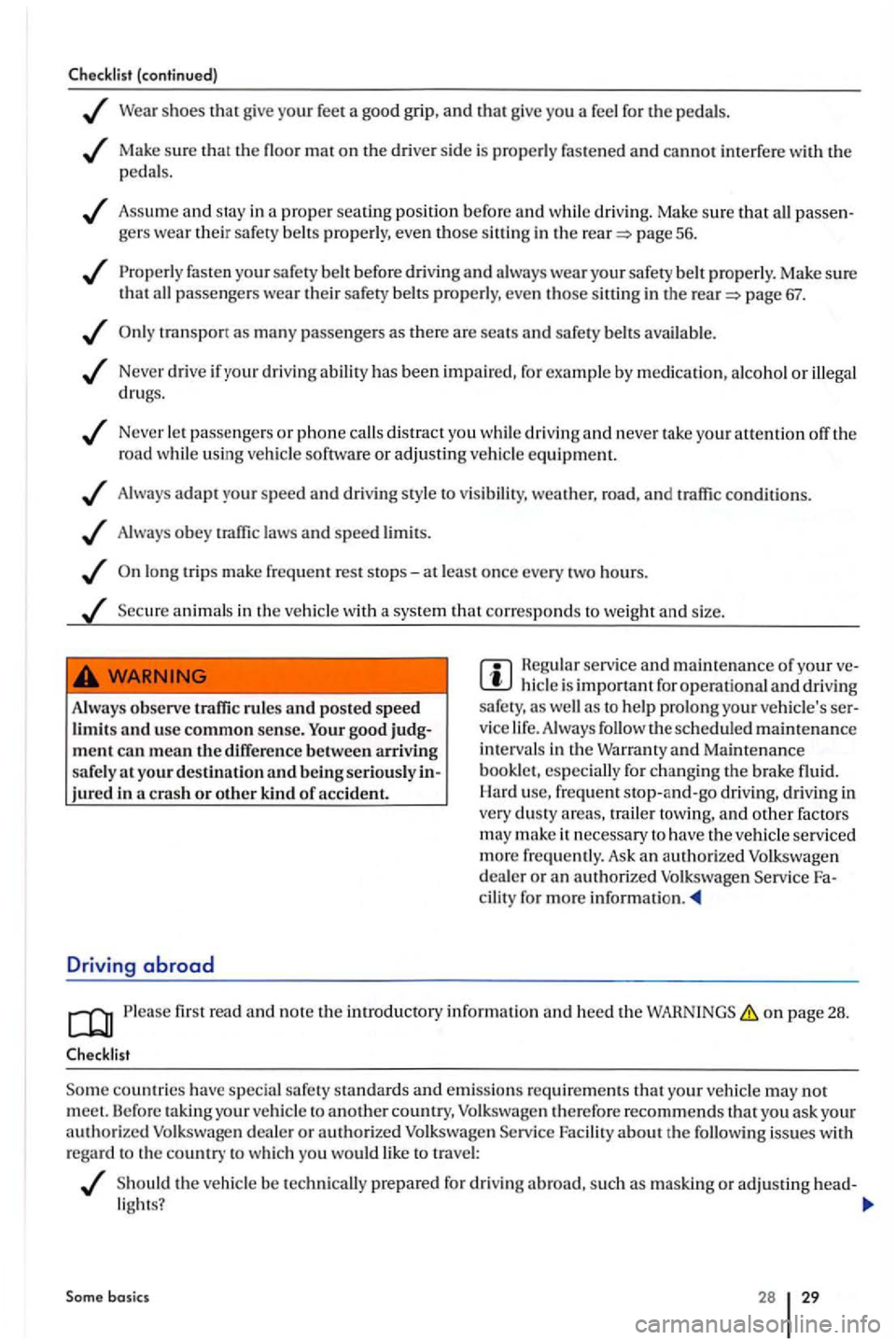
Checklist (contin ue d)
shoes th at give your feet a good grip , a n d that g ive you a feel for the pedals .
Make sure that th e floo r mat on the driver side is pro perly fastened and cannot interfere with th e
peda ls .
Assume and s tay in a proper seatin g positi o n before and driving. Make sure that gers wear their sa fety properly, eve n those siuing in the page 56 .
fasten your safety
transport as m any passenger s as
Never drive if your driving ability has been impaired , for exa mple by medication, alco hol or
Neve r le t passe nge rs o r phone d istract you driving and neve r take your attention off the road using vehicle software or adjustin g vehicle equipment.
Always adapt your speed and dri ving style to v isibility , weather, road, and traffic conditions .
Always obey traffic laws and speed limits .
long trips make freque n t rest stops -at least once every two hou rs.
Sec ure
animals in the vehicl e w ith a syste m that corresponds to we ight and s ize.
Always observe traffic rules and posted speed limits and use common sen se. good ment can mean th e diff erence between arrivi ng safe ly at your destination and b eing seriousl y jured in a crash or other kind of acci dent .
Driving abroad
Hegu lar serv ice and maintenance of your hide is important for operational and drivin g
safe ty, as the sc heduled maintenance
int erva ls in the
towing, and other fac tors
m ay make it necessary to have the ve hicl e serv iced more freque ntly. Ask an authorized Volk swage n
dea ler or a n authorized Volkswagen Service
on page 28 .
Checklist
issues with
regard to the country to which yo u wo uld like to travel:
Should the ve hicl e be technically prepared fo r dri vin g abroad, such as masking or adjustin g head-light s?
Some basics 28 29
Page 86 of 541
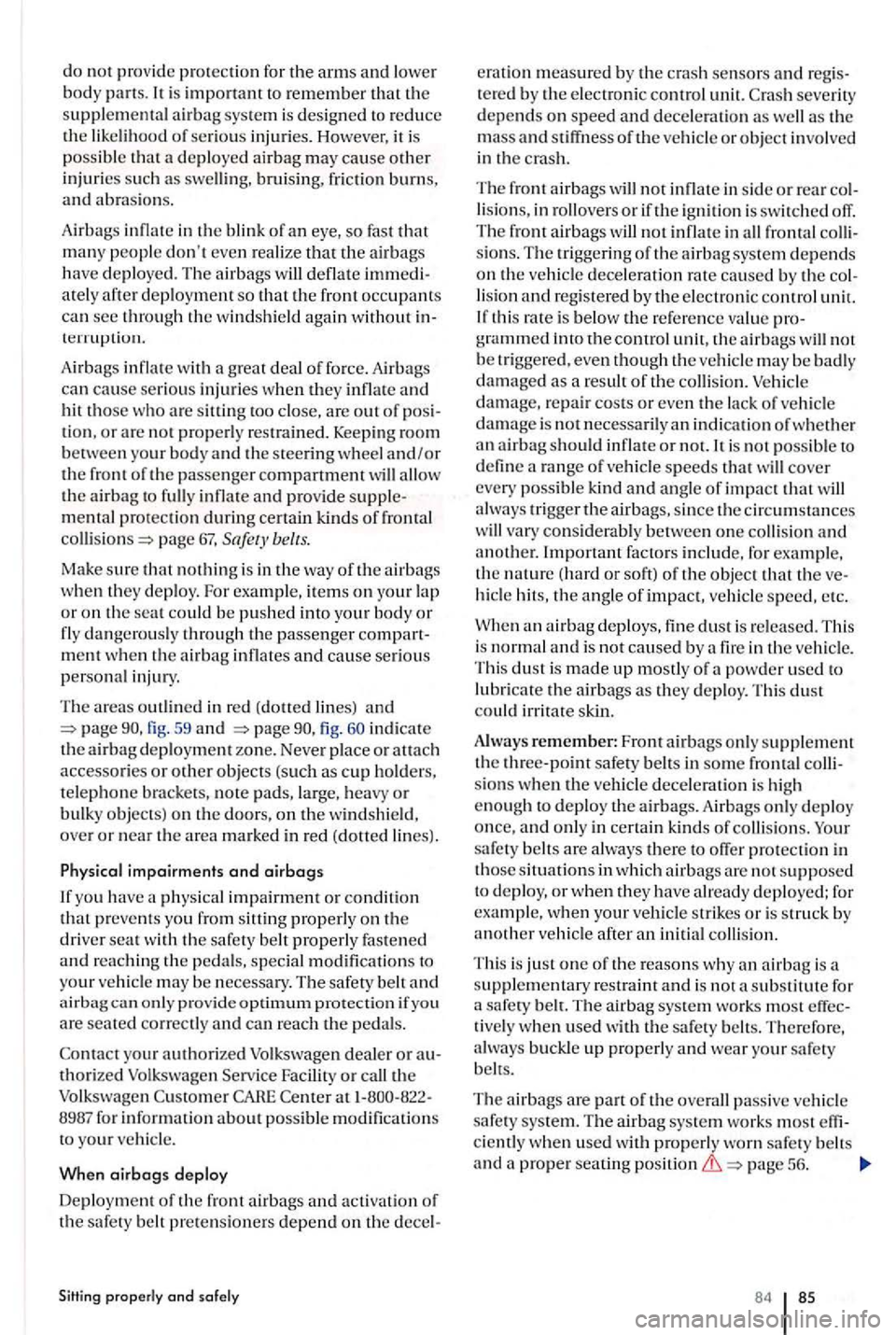
do not provide protectio n for the arms and lower body parts. is important to remember that th e
supple m ental airbag system is designed to reduce the likelihood of serious in juries. However, it is poss ibl e that d ep lo ye d airbag may cause other injurie s such as swelling, bruising, friction burns, and abrasio ns.
A irba gs inflat e in
the blink of an eye, so fast that many people don't eve n realize th a t the airbags
h ave dep loyed. The a irbags will deflate ate ly after deployment s o that th e front occupants can see th roug h the windshield again without terruption.
A ir
bags inflat e with a grea t deal of fo rce. Airbags can cause serious in juries when they infl ate and hit those who are sittin g too close, are out of
mental protection durin g certain kinds of frontal
collisio ns page 67, Safety belts.
Make s
ure that nothing is in the way of the airbags when th ey deploy. For example, items on your lap or o n th e seat could be pushed into yo ur body or fly dangero usly through the passenger ment w he n the ai rbag inflates and cause serio us personal injury.
T he areas outlined in red (dolled lines) and fig. 59 and fig. ind icate the airbag deployment zone. Never place o r aLtach
accessories or other o bjects (such as cup hold ers, telephone bracke ts, note pads, large, heavy or bulky objects) on the doors, on the w indshie ld, over or near the area marked in red (dotted lin es) .
Physical impairm ents and airbags
If yo u have a physica l impairment o r condition that prevents yo u f rom sitting properly o n the driver seat with the safety belt properly fastened
a n d reach ing the pe dal s, special modifications to
your ve hicle may be necess ary. The safety belt and airbagcan only provide optimum p rotection if you
are seated correct ly and can reach the p ed als.
thorized Volkswagen Service Facility or call the
te red by the electron ic control unit. seve rity
depends on speed and decele rati on as well as the mass and stiffn ess of the ve hicle or object in vo lved
in the cras h.
The front airbag s will not inflat e in sid e or rear lisio ns, in roll overs or if the ig niti on is swi tc h ed off .
T he front airbags will not inflate in all frontal sions. The trigger ing of th e a irbag system depends on th e ve hicle dece le rat ion rat e caused by the lisio n and registered by the electr onic control unit. If th is rat e is below the refer ence va lue grammed the control unit, th e a irba gs will not be trigge red, even though the vehicle may be badly damaged as a resu lt of the collision. Vehicl e
damage, repair costs or even the lack of ve hicl e damage is not necessarily an ind ication of whether
a n airbagshould inflat e or not. It is not possib le to
defi ne a range of vehicl e speeds w ill cove r
every possibl e kind and angle of impact that will
a lways trigger the airbag s, s ince th e c ircumstances
will vary con sid erably between one collis ion and a not her. Important facto rs include, for example , the nature (hard or soft) o f the objec t that the hicl e hit s, the angle of impact, ve hicle speed , etc.
When a n airbag deploys, fine dust i s released. This
i s normal and is not caused by fire in the ve hicle.
T hi s d ust is made up mostly of a powder used to
lub ricate the airbags as
s ions when the veh icle deceleration is high enough to depl oy the airbags. Airbags onl y deploy
once, and o nl y i n certain kinds of collisions. safet y belts are always there to offer protectio n in
th ose situ ation s in which airbags are no t s upposed to dep loy, or when they have already deployed; fo r example, when your vehicl e strikes or is st ru ck by
anothe r ve hicle after an initial coll is ion.
is just one o f the reasons w hy a n air bag is supplementary restraint and is not a substitute for a safe ty belt . The airbag syste m wo rks most
The air bags are pan of the overall passive vehicl e safe ty sys tem. The airbag system works most cie ntly when used with properly safety be lts and a proper seatin g posit ion
84 85
Page 88 of 541
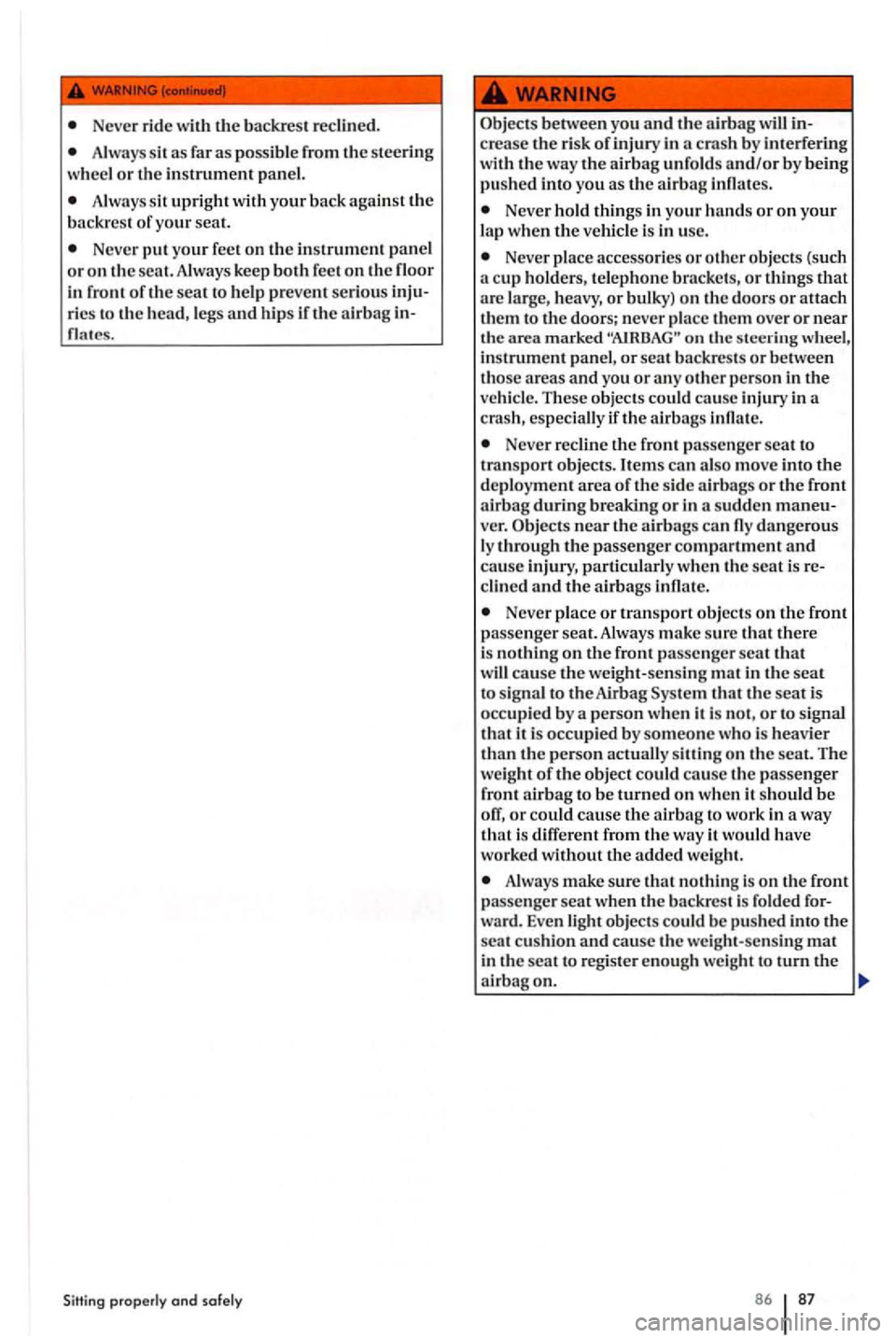
Never rid e with th e ba ckres t reclined.
Always sit p ossib le from the steering
w heel or th e in strument pan el.
A lways sit upri ght with your back
Never your feet on the instrument panel or on th e sc at. Alwa ys keep both fee t on the floor
in front of th e seat to help prevent serious
flat es.
Obj ects between you the airb ag
Never hold things in your hands or on your lap when the ve hicl e is in usc.
Never place accessories or other objects (su ch cup hold ers , telephone bracke ts , or thing s that
a re heavy, or bulky) o n th e door s or attach
th em to the doors; neve r place th em over or near the area marked ''AIR
Never re cline
side airbags or the front
ai rb ag during breaking or in sudden ver. Obje cts near the airbags can n y dangerous
l y through the passenger comparlment and
ca use inju ry, particularly when th e seat is cli ne d and the airbags innat e.
Never place or transport obj ec ts on the front
pa sse nger seat. Alwa ys make sure
is different from the it would have
wo rked without the added we ig ht.
Always make sure that no thin g is o n th e front
passenger seat when th e ba ckre st is folded
w ard. Even light ob jec ts co uld be pus hed into th e
s ea t c u shion and cause the weig ht-sen sing mat in the scat to register enough weig h t to turn the
airbagon.
86 87
Page 93 of 541
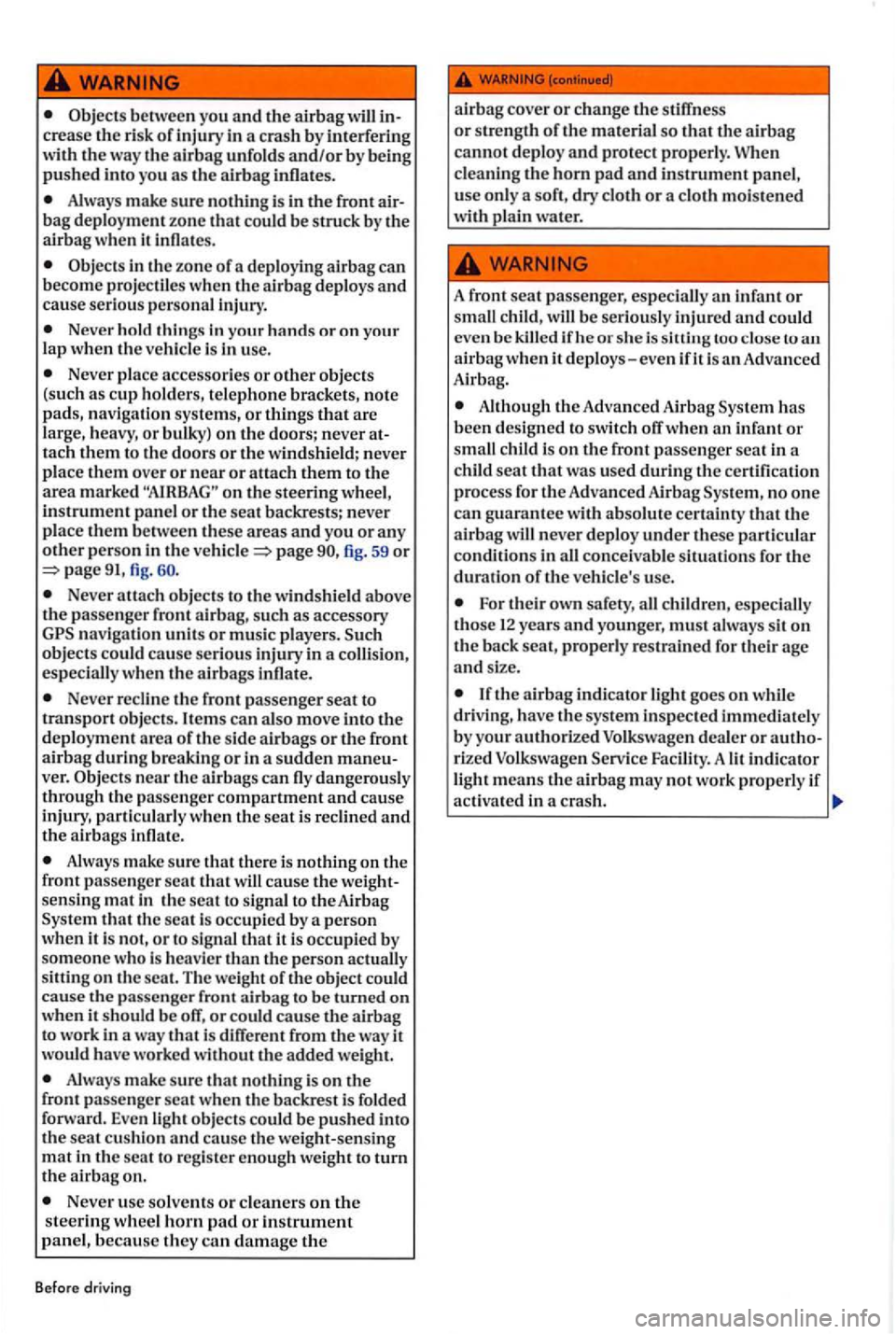
Always make sure nothing is in the front airbag deploym ent zone that could be struck by the airbag when it inflates.
Never hold things or on your lap when the vehicle is in use.
Never place accesso ries or other objects
(such as cup holders, tel ephone brackets, note pads, navigation systems, or things that are large, heavy, or bulky) on the doors; never attach them to the doors or the windshield; never place th em over or near or attach them to the area marked
fig. 59 or 91, fig.
Never attach objects to the windshield above the passenger front airbag, such as accessory navigation units or music player s.
Never recline th e front passenger seat to transport objects. can also move into the deployment area of the side airbags or the front airbag during breaking or in a sudden maneuver. near th e a irbags can fly dangerously through the pass enger compartment and cause injury, particularly when the seat is reclined and the airbags inflate.
Always make sure that there is nothing on the front passe nger seat that will cause the weightsensing mat in the scat to signal to theAirbag that the scat is occupied by a person when it i s not, or to signal that it is occupied by someone who is heav ie r than the person actually
sitting on th e sca t. The weight of th e object could cause the passenger front airbag to be turned on when it should be off, or could cause the airbag to work in a way that is differ ent from the way it
would have worked without the added weight.
Alwa ys make sure that nothing is on the front passenger seat when the backrest is folded
forward. Even light objec ts could be pushed into the seat cu shi on and cause th e weight-sensing mat in the seat to re gister enough weight to turn the airbag on.
Never usc solvents or cleaners on the steering wheel horn pad or instrument panel, because they can damage the
Before driving
airbag cover or change the stiffne ss or strength of the material so that the airbag cannot deploy and protect properly. When cleaning the hom pad and instrumen t p anel, use only a soft, dry cloth or a cloth moist en ed
with plain water.
A front seat passenger, especially an infant or small child, will be seriously injured and could
eve n be killed if he or she is
Although the Advanced Airbag has been designed to switch off when an infant or child is on the front passenger seat in a child seat that was used during the certification
process for the Advanced Airbag no one can guarantee with absolute certainty that the airbag never deploy under these particular conditions in all conceivable situations for the duration of the vehicle 's use.
For their own safety, all children, especially those 12 years and younger, mus t always sit on the back seat, properly restrained for their age and size.
Facility. A lit indicator light means the airbag may not work properly if
activated in a crash.